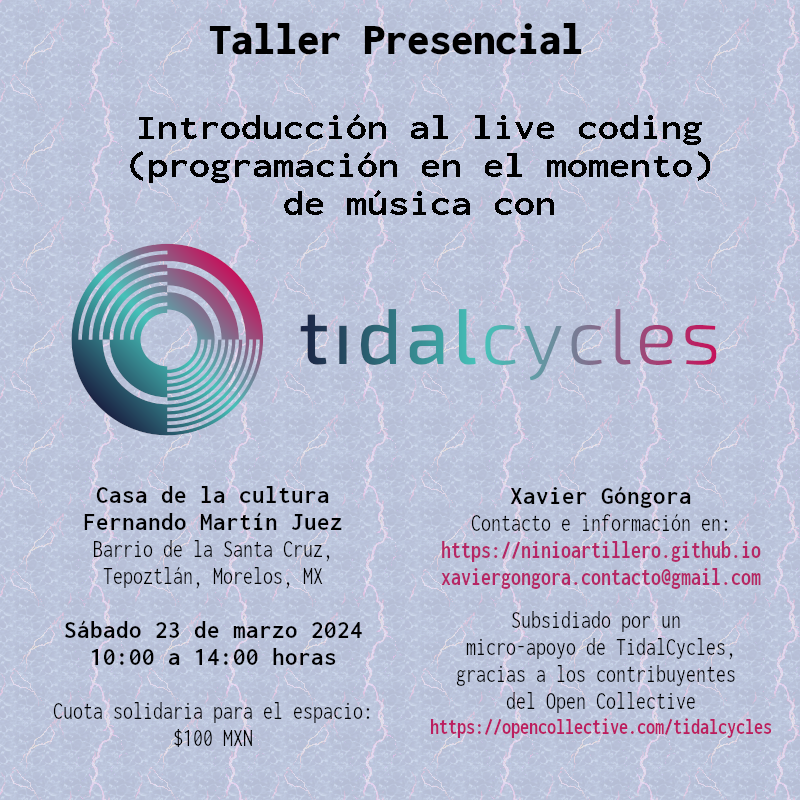Live coding with Tidal Cycles Workshop in Tepoztlán
Last year I got a Tidal Cycles micro-grant in October to organize a live coding introductory workshop in Tepoztlán.1 My first son was born the month after and it has been an awesome ride! This little person is quite demanding, but also incredibly inspiring. I was finally able to give the workshop on March this year.

Tepoztlán
Tepoztlán is located about 70 kilometers south of Mexico City, in a valley of steep mountains (that seem to have been pushed out from the underground) and lush glens during rainy season. It is a town proud of its traditions with a remarkable cultural and religious syncretism. I’ve been living here for 7 years, and will continue for the foreseeable future.

We are currently facing environmental and social imbalance caused by a complex real state black market, that neglects the National Park status and regulations, and annual fires that threaten the ecosystem. In this context, nurturing community is critical to counteract the dismantling of the social fabric. This is no easy task, as the social spheres seem to orbit different stars at times. Before this workshop I gave a talk at the central church about algorithms and live coding practice. So this is a second effort towards sharing both my artistic and research interests with my local community, as most of my activities are usually online or in Mexico City.
Assistants and venue

Four people came to the workshop. Alejandro is an economist but works as a carpenter for a living. Roberto is a front-end developer and environmental activist that links the preservation of the mountains and forests with the rights of the indigenous people of Tepoztlán. A second Alejandro is a high school senior involved with his neighborhood committee, he wants to study to become a mechatronics engineer. Finally, Oscar is a systems engineer and part of the Forest Ranger Association of Tepoztlán. All of them are native to Tepoztlán and value art as an expression of freedom. They are pretty aware of the contradictions and tensions that their hometown hosts.

The venue was Fernando Martín Juez’s house in the Santa Cruz neighborhood near the west mountain side. Fernando was an architect and designer that appointed his house to become a Cultural Center after his passing. He made the necessary arrangements for an association of friends and neighbors to manage the place and make it a contribution to the people of Tepoztlán. Unfortunately, the funds he left to kickstart activities are being held hostage by a bank (legal action has moved slowly), and the doors have stayed shut except for some isolated events (of which ours is an example). The house has an exotic architecture, a rich color palette, and is full of little artifacts that Fernando collected. It was really a nice place to held the workshop and could become a spot for live coding sessions.
The workshop
For the first half of the workshop I gave an introductory talk. First we discussed free and open source software as a strategy to harness community efforts and build people centered technology. Then I talked about what live coding in general, sharing some online references and broadly explained what it meant in the context of computer music. This set the stage to introduce Tidal’s architecture. Before the break, we watched a video performance of Alex McLean (Tidal’s creator) doing a from-scratch session. The slide presentation is available here.

After cookies and coffee, the second part of the workshop was about getting hands-on.
I briefly introduced Tidal’s installation procedure with reference to the official documentation for them to attempt an installation at home.
Then I made a live demonstration showing the basics of sound reproduction, the mini-notation and some pattern
transformations (like fast, slow, (<~), jux and rev).
I also talked about function’s inputs and outputs, to provide a better understanding of Tidal’s syntax.
Finally we ran an estuary session for collective improvisation.
It was fun seeing them go wild with the few functions I showed them.
Aftermath
In this first workshop I might have overwhelmed the participants by showing too much notation too soon. Next time we could do short solo test rounds when introducing syntax elements. This might improve the understanding of all and help build confidence. Furthermore, those rounds could be structured by following an introductory tutorial.
This was fun and I hope more people join, but I know developing a practice community takes time. It’s not easy for people to commit, specially with everyone being so busy. I’ll keep making the call so anyone near looking for something like live coding can find us.
Workshop pictures and details (in spanish).
-
Thanks to the Tidal Cycles contributors of the Open Collective for making it possible through a micro-grant. ↩